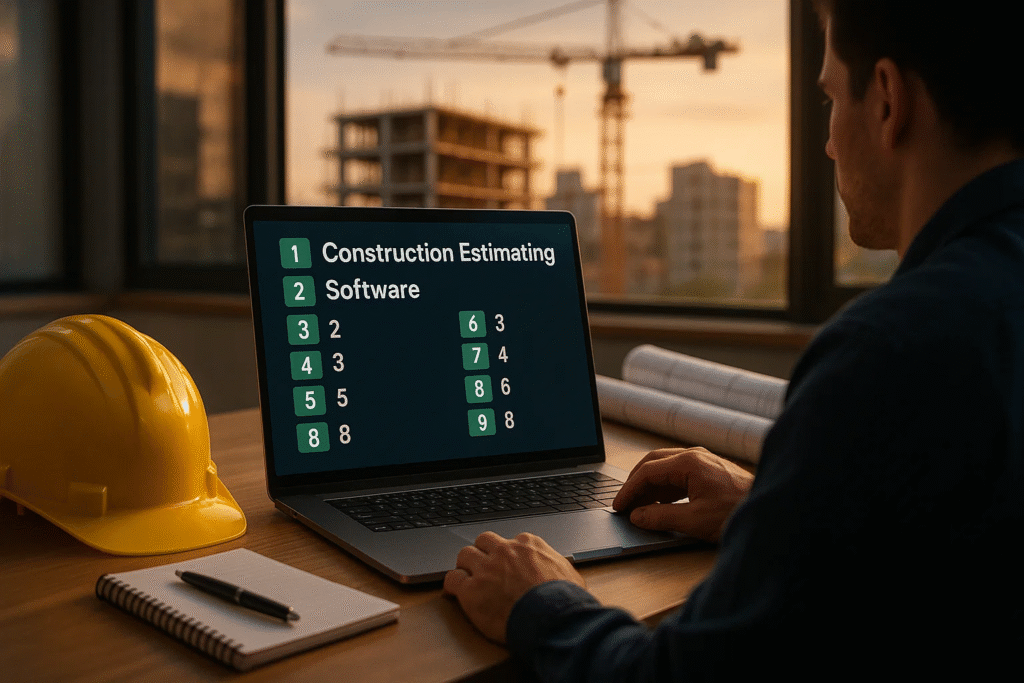Key Takeaways
- Discover the most efficient and reliable construction estimating software for 2025, tailored to various project sizes and business needs.
- Compare features, pricing models, user ratings, and integrations to identify the best-fit platform for accurate cost estimation and project planning.
- Learn how top tools like Procore, PlanSwift, and Buildxact enhance productivity, minimize errors, and streamline workflows for modern contractors.
In the fast-evolving world of construction, precision and efficiency have become non-negotiable elements of project success. As we step further into 2025, the construction industry continues to embrace digital transformation, with cost estimation software playing a pivotal role in shaping smarter, faster, and more accurate project planning. Construction estimating software is no longer a luxury reserved for large contractors; it has become an essential tool for builders, architects, engineers, quantity surveyors, and project managers across the spectrum—from small-scale residential jobs to large commercial and infrastructure developments.

Estimating software helps professionals generate accurate project cost projections, reduce manual errors, manage budgets, streamline bidding processes, and ultimately improve the bottom line. With rising material costs, labor shortages, and increasing client demands for transparency and accountability, construction firms are under more pressure than ever to deliver timely and accurate estimates. This growing demand has led to the rapid development and refinement of a wide variety of estimating platforms, each offering unique features, integrations, and capabilities tailored to different segments of the industry.
The market in 2025 is rich with options, ranging from cloud-based solutions with AI-powered automation to highly customizable desktop tools that offer deep functionality and data analysis. Many of these platforms are also integrated with broader construction management ecosystems, enabling end-to-end workflow integration from initial estimate to final delivery. Whether you are a solo contractor looking to simplify your bidding process, a mid-sized firm focused on growth, or a large enterprise handling multi-million-dollar projects, choosing the right estimating software can significantly impact your operational efficiency and profitability.
However, with so many tools available, selecting the most suitable construction estimating software can be a daunting task. Key factors such as pricing models, ease of use, integration with existing tools, scalability, customer support, and specific features for cost tracking, takeoff, and reporting must all be considered. Moreover, 2025 is witnessing a surge in AI-driven capabilities, cloud-based collaboration, mobile access, and compliance-oriented functionalities—further complicating the decision-making process for construction professionals.
To help you navigate this complex landscape, we’ve curated a detailed guide to the Top 10 Construction Estimating Software to Try in 2025. This comprehensive list includes both well-established industry leaders and emerging platforms that are gaining momentum due to their innovation and user-centric design. Each software has been evaluated based on its core features, usability, performance, customer feedback, and adaptability to current industry challenges and technological advancements.
Whether you are looking to enhance accuracy, reduce overhead, improve your win rate on bids, or simply gain better control over your project finances, this guide is designed to help you make an informed decision. Read on to discover the tools that are setting the standard for construction estimating in 2025—and find the one that best aligns with your business needs and goals.
Before we venture further into this article, we would like to share who we are and what we do.
About 9cv9
9cv9 is a business tech startup based in Singapore and Asia, with a strong presence all over the world.
With over nine years of startup and business experience, and being highly involved in connecting with thousands of companies and startups, the 9cv9 team has listed some important learning points in this overview of Top 10 Construction Estimating Software To Try in 2025.
If your company needs recruitment and headhunting services to hire top-quality employees, you can use 9cv9 headhunting and recruitment services to hire top talents and candidates. Find out more here, or send over an email to [email protected].
Or just post 1 free job posting here at 9cv9 Hiring Portal in under 10 minutes.
Top 10 Construction Estimating Software To Try in 2025
- STACK
- ProEst
- PlanSwift
- Buildxact
- CoConstruct
- Procore
- Bluebeam Revu
- RedTeam
- Contractor Foreman
- Autodesk Construction Cloud
1. STACK

STACK has emerged as one of the Top 10 Construction Estimating Software Solutions to Try in 2025, primarily due to its dynamic cloud-based architecture, AI-enhanced takeoff capabilities, and seamless integration across construction workflows. Established in 2011, STACK continues to redefine digital preconstruction processes for contractors, estimators, and project managers worldwide.
This in-depth review evaluates why STACK remains a compelling solution for firms aiming to enhance estimating precision, streamline collaboration, and increase bid-win ratios in 2025’s competitive construction landscape.
Key Features That Set STACK Apart in 2025
1. AI-Enhanced Digital Takeoff and Estimating Tools
- Automated Quantity Takeoff
- AI-powered tools expedite the measurement of materials and quantities from digital blueprints.
- Reduces manual input and potential errors in early-stage cost estimation.
- Real-Time Cost Data Integration
- Dynamic pricing updates integrated with local and national databases.
- Ensures estimates remain accurate and competitive even as material and labor costs fluctuate.
2. Cloud-Native Infrastructure
- Universal Accessibility
- Access from any device, any location, without dependence on desktop installations.
- Ideal for remote teams, multi-office contractors, and on-site estimators.
- Real-Time Team Collaboration
- Multiple stakeholders can work simultaneously on the same project.
- Enhances communication between preconstruction, design, and field teams.
3. User Experience and Interface Design
- Intuitive Interface
- Minimal learning curve for entry-level users.
- Advanced features structured logically for professional estimators and project leads.
- Visual Takeoffs
- Blueprint overlays and color-coded markups offer clear visual insight.
- Aids in communication between technical and non-technical stakeholders.
4. Workflow Integration and Compatibility
- Seamless Software Integration
- Connects directly with leading project management and accounting tools such as Procore, Buildertrend, PlanGrid, and QuickBooks.
- Workflow Automation
- Reduces redundancy and manual handoffs between takeoff, budgeting, and project execution stages.
Performance Metrics and Business Impact
Measurable Results Delivered by STACK
- 10x Faster Bidding
Contractors report significantly shorter turnaround times for bid submissions. - 35% More Win Opportunities
By submitting faster and more accurate bids, users increase their competitiveness. - High ROI Across Company Sizes
Scalable pricing and capabilities suit solo estimators, mid-size teams, and enterprise-level construction firms.
Subscription Plans and Cost Transparency
| Plan Type | Target Users | Starting Price (Annual) | Free Version | Custom Pricing Available |
|---|---|---|---|---|
| Basic | Small teams, freelancers | $2,499 | Yes | No |
| Pro/Enterprise Tiers | Mid to large construction firms | Varies based on user count | No | Yes |
- Subscription-based SaaS model with predictable costs.
- Free trial available to evaluate essential features before commitment.
User Feedback and Satisfaction Ratings
Customer Sentiment Analysis
| Platform | Rating | Review Count | Top Praised Features | Reported Limitations |
|---|---|---|---|---|
| G2 | 4.7/5 | 1,408 reviews | Accuracy, usability, cloud access | Limited customization for reports |
| Capterra | 4.5/5 | 1,388 reviews | Takeoff speed, interface design | Learning curve for advanced tools |
- High User Retention
Majority of reviews cite continued satisfaction post-deployment. - Strong Community Support
Active user forums and documentation make onboarding and issue resolution straightforward.
Competitive Evaluation Matrix: STACK vs. Key Competitors (2025)
| Feature Category | STACK | ProEst | PlanSwift | Buildertrend |
|---|---|---|---|---|
| AI-Based Takeoff | Yes | No | Limited | No |
| Cloud-Based Platform | Yes | Yes | No | Yes |
| Mobile Access | Yes | Yes | Limited | Yes |
| Project Management Integration | Extensive | Moderate | Basic | Extensive |
| Real-Time Collaboration | Yes | No | No | Yes |
| Cost Database Integration | Yes | Yes | No | Yes |
| Pricing Flexibility | Moderate | Moderate | High | High |
| Free Version Available | Yes | No | Yes | No |
Potential Drawbacks to Consider
- Customization Limitations
- Users seeking deeply tailored reporting formats may find customization features limited.
- Initial Learning Curve
- Advanced features like layered takeoffs or cost aggregation dashboards require moderate training.
- Pricing for Small Firms
- Entry-level pricing might be steep for micro-contractors or independent estimators.
Final Verdict: Why STACK Is a Top Construction Estimating Software in 2025
STACK ranks among the top-tier estimating solutions for 2025 due to its:
- Exceptional AI-driven takeoff automation.
- Cloud-native ecosystem that enables seamless remote collaboration.
- High compatibility with major construction software.
- Proven ROI and user satisfaction validated by thousands of professionals.
For firms focused on speed, precision, and digital transformation, STACK represents a robust, forward-looking platform capable of driving operational efficiency and enhancing bid success in a highly competitive construction market.
2. ProEst

In the ever-evolving landscape of digital construction, ProEst by Autodesk remains a cornerstone solution for firms aiming to streamline and elevate their estimating workflows. Originally founded in 1976 and later acquired by Autodesk in 2021, ProEst brings decades of industry expertise into a modern, cloud-based architecture that continues to shape how contractors manage preconstruction processes.
Recognized as one of the Top 10 Construction Estimating Software to Try in 2025, ProEst offers a robust platform tailored to meet the demands of general contractors, subcontractors, and project managers seeking accurate cost projections, efficient workflows, and scalable solutions in an increasingly competitive market.
Core Capabilities That Define ProEst’s Competitive Edge in 2025
1. Cloud-Based Infrastructure and Accessibility
- 100% Cloud-Hosted Platform
- Eliminates the need for on-premise servers and reduces IT overhead.
- Enables team members to work from any location with full data access and synchronization.
- Secure Cloud Storage
- Ensures reliable and encrypted data backup, version control, and multi-user access.
- Ideal for hybrid teams operating across job sites, regional offices, and home environments.
2. Digital Takeoff and Estimating Tools
- Efficient Takeoff Capabilities
- Supports rapid generation of accurate quantities from uploaded drawings.
- Reduces reliance on manual calculations, improving accuracy and reducing risk.
- Pre-Built and Customizable Estimating Templates
- Standardizes bidding processes while allowing project-specific flexibility.
- Enables estimators to maintain consistency across large portfolios.
3. Seamless Software Integration
- Native Integration with Autodesk Ecosystem
- Fully interoperable with Autodesk Construction Cloud, AutoCAD, and Revit.
- Enhances connectivity between design, estimation, and execution workflows.
- Cross-Platform Compatibility
- Supports integration with industry tools like Procore, Sage, Viewpoint, and Microsoft Excel.
4. Advanced Reporting and Business Intelligence
- Dynamic Dashboards
- Customizable reporting dashboards help visualize project cost trends and estimate performance metrics.
- Comprehensive Budget Analysis Tools
- Tracks estimate-to-budget variance and improves financial planning and accountability.
5. Built-In CRM (Customer Relationship Management)
- Client Interaction Management
- Allows users to track client histories, manage follow-ups, and personalize communication during the bidding phase.
- Strengthens client relationships and enhances proposal responsiveness.
User Sentiment and Performance Metrics
Customer Ratings Snapshot
| Platform | Rating (2025) | Review Count | Most Praised Features | Areas for Improvement |
|---|---|---|---|---|
| G2 | 4.3 / 5 | 62 | Cloud functionality, CRM, template design | Usability learning curve |
| Capterra | 3.6 / 5 | 52 | Estimating speed, integration options | Cost for smaller firms, feature gaps for large enterprises |
- General Sentiment:
- Widely recognized for its professional-grade tools and high reliability.
- Users appreciate Autodesk’s continuous development and support ecosystem.
Pricing Structure and Scalability
| Plan Type | Target Audience | Starting Price (Annual) | Free Trial | Custom Quoting Available |
|---|---|---|---|---|
| Enterprise Licensing | Mid to Large Construction Firms | ~$5,000 | No | Yes |
- Subscription-Based Model
- Pricing typically requires direct contact with the vendor due to its custom deployment model.
- Scalable for Large Teams
- Particularly well-suited for firms managing high-volume bids and complex, multi-phase projects.
Evaluation Matrix: ProEst vs. Key Competitors in 2025
| Feature Category | ProEst (Autodesk) | STACK | PlanSwift | Buildxact |
|---|---|---|---|---|
| Cloud-Based Estimating | Yes | Yes | No | Yes |
| AI-Driven Takeoff | No | Yes | Limited | No |
| CRM Integration | Yes (Built-in) | No | No | Yes |
| Autodesk Ecosystem Integration | Yes | No | No | No |
| Reporting and BI Tools | Advanced | Moderate | Basic | Moderate |
| Free Trial Availability | No | Yes | Yes | Yes |
| Entry Cost Accessibility | Medium | Medium | High | Low |
Strategic Advantages of Using ProEst in 2025
Why Construction Firms Choose ProEst
- Decades of Industry Legacy
- Established reputation with over 8,000 companies relying on it worldwide.
- Autodesk Backing
- Assurance of innovation, support, and compatibility within a leading digital construction ecosystem.
- High Customizability
- Templates, workflows, and reports can be tailored to specific business needs.
- Enterprise-Grade Security and Compliance
- Meets the regulatory and data security requirements of large-scale contractors.
Identified Limitations and Considerations
- Cost Barrier for Small Firms
- Entry-level pricing may be beyond reach for small businesses or independent contractors.
- Advanced Feature Learning Curve
- Requires initial training to fully leverage its extensive capabilities.
- Limited Specialty Features
- May lack deep customization for niche verticals or unique estimation models used by specialized firms.
Conclusion: ProEst’s Role in Shaping the Future of Construction Estimating
As construction firms in 2025 seek to modernize their preconstruction and estimating practices, ProEst by Autodesk stands out as a time-tested, technologically advanced solution. Its integration into the Autodesk ecosystem enhances its functionality and future-proofing, while its powerful CRM, takeoff automation, and cloud capabilities offer significant advantages for firms operating in both competitive and collaborative construction environments.
Ideal For:
- Medium to large firms requiring scalable, cloud-based estimating tools.
- Contractors seeking integration with Autodesk tools and long-term reliability.
- Teams looking for enhanced client management directly within estimating workflows.
ProEst’s strategic position within the Autodesk Construction Cloud ecosystem ensures it will remain a leader in digital estimating technology well into the future.
3. PlanSwift

In the evolving domain of construction technology, PlanSwift by ConstructConnect has remained a dependable and widely adopted solution for digital takeoff and cost estimation. It continues to attract attention in 2025 for its intuitive interface, precise calculation tools, and integration flexibility—making it an essential asset for contractors who prioritize speed, accuracy, and ease of use in preconstruction planning.
Despite increasing competition from newer AI-powered platforms, PlanSwift has retained its market relevance through consistent upgrades and affordability, thereby maintaining its reputation as a preferred software for general contractors, estimators, and project managers.
Core Strengths That Position PlanSwift Among the Top Estimating Tools in 2025
1. Efficient Digital Takeoff and Estimating Workflow
- Drag-and-Drop Takeoff Interface
- Allows users to quickly perform material and labor estimates from digital blueprints with minimal manual input.
- Supports both 2D plan files and multi-layered drawing formats.
- Customizable Assemblies and Formulas
- Users can create reusable templates for common projects or trades, significantly reducing bid preparation time.
- Built-in cost structures accommodate dynamic material pricing and labor rates.
2. Seamless Integration With Industry Software
- Bidirectional Integration
- Interfaces effectively with platforms such as:
- Procore (project management)
- Buildertrend (construction lifecycle platform)
- Excel (spreadsheet analysis and legacy compatibility)
- Interfaces effectively with platforms such as:
- Improved Collaboration
- Estimating data can be smoothly transferred into project execution platforms, reducing rework and data entry duplication.
3. Simplified Learning Curve for Beginners
- User-Centric Design
- Especially valued by small to mid-sized firms for its minimal onboarding requirements.
- Basic training is included with most licenses, and tutorial libraries are readily accessible.
- No Internet Required
- Unlike cloud-native competitors, PlanSwift is a desktop-based solution, which may benefit users in environments with unreliable internet connectivity.
Pricing Structure and Licensing Overview
| License Type | Cost (Annual) | Included Features | Trial Availability |
|---|---|---|---|
| Single-User License | $1,749/year | Full access to estimating tools, takeoff engine, and support | 14-day free trial |
| Add-on Modules | Varies | Electrical, plumbing, HVAC-specific modules | Yes (optional) |
- Budget-Friendly Solution
- Compared to enterprise-grade software, PlanSwift offers high value for cost-conscious users.
- No recurring cloud hosting or storage fees.
User Ratings and Feedback Analysis
User Satisfaction Insights
| Platform | Rating | Review Volume | Highly Rated For | User Concerns |
|---|---|---|---|---|
| G2 | 4.4 / 5 | 32 Reviews | Accuracy, ease of navigation, quick adoption | Advanced tool complexity |
| Capterra | 4.3 / 5 | 398 Reviews | Cost efficiency, takeoff functionality | Dated UI, limited mobile functionality |
- Positive Reception Across the Board
- Most users report strong satisfaction with core features and reliability.
- Criticisms primarily focus on limitations in UI modernization and mobile capabilities.
Feature Comparison Matrix: PlanSwift vs. Competitors (2025)
| Feature Category | PlanSwift | STACK | Buildxact | ProEst |
|---|---|---|---|---|
| Deployment Model | Desktop | Cloud-Based | Cloud-Based | Cloud-Based |
| Digital Takeoff Tools | Advanced | Advanced (AI-aided) | Moderate | Moderate |
| Integration Capabilities | Strong (Excel, Procore) | Strong | Moderate | Strong (Autodesk) |
| Cost Accessibility | High (Affordable) | Medium | High | Low (Enterprise-tier) |
| Mobile Support | Limited | Full | Full | Full |
| Best For | Small to Mid Firms | Mid to Large Firms | Builders & Remodelers | Enterprise Contractors |
Reasons PlanSwift Remains a Top Choice in 2025
Targeted Advantages for Construction Firms
- Ideal for Quick Deployment
- Firms can be fully operational within hours of installation, with minimal IT requirements.
- Trusted by Estimators for Over a Decade
- Longevity in the market and consistent updates give users confidence in long-term software viability.
- Strong Ecosystem Compatibility
- Easily fits into existing tech stacks without major overhaul or migration efforts.
- Customization Without Complexity
- Offers flexible setup without the burden of enterprise-level learning curves or customization delays.
Notable Limitations and Considerations
- Lacks Full Cloud Functionality
- Not suitable for teams that require real-time multi-user collaboration across distributed locations.
- Mobile App Gaps
- Mobile companion tools are either underdeveloped or missing, restricting field usage.
- Interface Design Slightly Outdated
- Compared to newer competitors, some users feel the UI/UX could benefit from a more modern overhaul.
Conclusion: Why PlanSwift Stands Strong in the 2025 Construction Estimating Software Market
PlanSwift continues to command a solid reputation in the construction technology market, particularly among small to mid-sized firms that require dependable digital takeoff capabilities without investing in cloud infrastructure or complex onboarding. Its affordability, extensive feature set, and integration with popular platforms like Procore and Excel make it a top-tier solution in 2025 for firms seeking a fast, accurate, and budget-conscious estimating tool.
Recommended For:
- Contractors needing a reliable offline estimating platform.
- Estimators who prefer precise, template-based workflows.
- Businesses focused on value over excessive feature sets.
As the construction software market grows increasingly cloud-native, PlanSwift remains a stalwart solution for those valuing efficiency, legacy stability, and ease of use—ensuring its inclusion in any serious list of the Top 10 Construction Estimating Software to Try in 2025.
4. Buildxact

Designed with the specific needs of small to mid-sized residential construction professionals in mind, Buildxact has emerged as a leading platform in the construction technology space. Its comprehensive toolset, highly intuitive user interface, and end-to-end lifecycle coverage make it one of the most efficient and practical estimating software options for builders and contractors in 2025.
Recognized by Forbes and Software Advice as a top-tier construction solution, Buildxact’s seamless integration of estimating, job management, and financial oversight places it firmly among the best platforms tailored to the unique operational workflows of growing construction businesses.
Core Features That Make Buildxact a Top 10 Construction Estimating Software in 2025
1. All-in-One Platform for Project Lifecycle Management
- Estimating and Quoting
- Auto-calculated material and labor costs derived directly from takeoff measurements.
- Customizable quote templates with branding and markup options.
- Job Management and Scheduling
- Gantt-style schedule builder to manage milestones, subcontractor availability, and deadlines.
- Real-time visibility into job progress through automated task updates.
- Purchase Orders and Invoicing
- Streamlines procurement through integrated PO generation and tracking.
- Links invoices to quotes and job progress for accurate financial control.
2. Purpose-Built for Small to Mid-Sized Contractors
- Simple, Guided Interface
- Designed for users without formal estimating backgrounds.
- Minimal onboarding time with drag-and-drop elements and easy cost updates.
- Cloud-Based Accessibility
- Full functionality from desktop and mobile browsers—ideal for office-to-site flexibility.
- Centralized data storage ensures all users access real-time project updates.
3. Integration with Accounting and Supplier Tools
- QuickBooks, Xero, and More
- Native accounting integrations allow direct syncing of financial data and job costs.
- Facilitates a seamless flow between estimates, supplier orders, and invoicing.
- Supplier Price List Integration
- Connects with supplier catalogs for live pricing updates.
- Ensures estimates remain current amid market fluctuations.
Pricing Structure and Value Offering
Buildxact offers tiered pricing to accommodate a range of business sizes and complexity levels. Each plan includes core features but scales based on user count and workflow depth.
| Plan Name | Monthly Cost (Annual Billing) | Users Included | Key Features |
|---|---|---|---|
| Entry | $133/month | 1 | Estimating, quoting, job tracking |
| Pro | $199/month | 2 | Full job scheduling, purchase orders, financial tools |
| Teams | Custom pricing | 3+ | Multi-user access, advanced reporting, team scheduling |
- Free Trial: 14-day free trial offered for evaluation.
- Scalability: Plans tailored to solo builders, growing teams, and multi-user project offices.
User Sentiment and Platform Ratings
User Experience Snapshot (2025)
| Review Platform | Average Rating | Total Reviews | Top Praised Features | Common Concerns |
|---|---|---|---|---|
| G2 | 4.4 / 5 | 41+ | Usability, takeoff precision, quoting speed | No native time tracking, pricing for small firms |
| Capterra | 4.6 / 5 | 200+ | Customer support, intuitive interface | Limited enterprise scalability |
- Users frequently commend Buildxact’s responsiveness to feedback, well-documented training materials, and clean dashboard layout.
- The lack of a built-in time-tracking system has been noted by some users managing hourly labor workflows.
Feature Comparison Matrix: Buildxact vs. Peer Solutions (2025)
| Feature Category | Buildxact | PlanSwift | STACK | ProEst |
|---|---|---|---|---|
| Target Audience | SMB Builders | Small Contractors | Mid to Enterprise | Enterprise Contractors |
| Estimating & Takeoff Tools | Advanced (built-in) | Intermediate | AI-enhanced | Template-driven |
| Job Scheduling | Included | Not Included | Not Included | Not Included |
| Invoicing & PO Management | Included | Partial (via export) | Not Core | Limited |
| Accounting Integration | QuickBooks, Xero | Excel (indirect) | Procore (indirect) | Full Autodesk Suite |
| Learning Curve | Low | Moderate | Moderate | High |
| Offline Accessibility | Cloud-Only | Desktop | Cloud-Only | Cloud-Only |
| Best Use Case | Builders/Remodelers | Simple Estimating | Bid Collaboration | Complex Enterprise Bids |
Why Buildxact Is a Leading Choice in 2025
Strategic Advantages for Construction Professionals
- Designed for Practical Use in the Field
- Unlike tools built purely for estimators, Buildxact suits builders who wear multiple hats—estimating, quoting, ordering, and managing.
- Support-Rich Environment
- Includes onboarding webinars, live chat support, and an extensive knowledge base, ideal for businesses new to digital construction tools.
- Recognized Industry Leadership
- Recommended by respected outlets such as Forbes Advisor and Software Advice for its clarity, comprehensiveness, and reliability.
Limitations to Consider
- Lacks Built-in Time Tracking
- Requires external tools for teams monitoring hourly work or field labor time.
- May Be Costly for Solo Practitioners
- Starting at over $130/month, the price may deter freelancers or part-time contractors seeking basic tools.
- Not Designed for Large-Scale Construction Enterprises
- Functionality favors residential and light commercial projects rather than complex infrastructure builds.
Conclusion: Buildxact’s Market Value as a Top 10 Construction Estimating Platform in 2025
Buildxact has successfully positioned itself as a holistic, user-focused software solution for construction professionals looking to enhance accuracy, speed, and financial transparency throughout their project lifecycle. With an emphasis on builder-friendly workflows, cloud-based convenience, and automated estimating tools, it addresses the everyday challenges faced by small to mid-sized contractors with precision and simplicity.
Its rising adoption and sustained user satisfaction in 2025 confirm that Buildxact is not just another tool—it is an integrated platform built for real-world construction business needs.
5. CoConstruct

CoConstruct stands as one of the most complete software ecosystems designed for custom home builders and remodeling contractors, offering a fully integrated cloud-based platform. With robust capabilities that span construction estimating, project scheduling, client communications, and financial oversight, CoConstruct has become a cornerstone tool for firms seeking to centralize their operations and enhance client satisfaction.
In 2025, as residential construction firms increasingly demand cohesive, digital-first solutions, CoConstruct distinguishes itself by offering both granular control and broad project visibility—earning it a solid position in the top 10 construction estimating software platforms for the year.
Why CoConstruct Is a Top-Tier Estimating Software in 2025
1. End-to-End Project Lifecycle Coverage
- Estimating & Proposal Generation
- Create accurate, professional proposals with real-time cost adjustments.
- Supports templates, preset assemblies, and markup control for fast quoting.
- Budgeting and Financial Management
- Links estimates directly to budgets and client selections.
- Tracks actual vs. projected expenses, enabling early issue detection.
- Project Scheduling
- Drag-and-drop Gantt charts keep subcontractors and clients informed.
- Synchronizes tasks and milestones with change order approvals and timeline updates.
2. Industry-Leading Client Communication Tools
- Client Portal Access
- A branded interface for clients to approve selections, view schedules, and communicate changes.
- Reduces miscommunication, delays, and scope creep.
- Change Order Management
- Automated documentation of change requests and approvals.
- Seamlessly integrates with budgeting and invoicing to maintain financial clarity.
3. Centralized Team Collaboration
- Subcontractor Coordination
- Assign tasks, share files, and confirm deliveries all in one centralized hub.
- Enhances accountability and improves build cycle timing.
- Mobile Accessibility
- Field teams can upload photos, make updates, and mark progress directly from smartphones or tablets.
Pricing Structure and Flexibility
CoConstruct offers subscription-based plans tailored to accommodate varying business sizes, team structures, and feature requirements.
| Plan | Monthly Cost (Starting) | User Access | Key Features |
|---|---|---|---|
| Core Plan | $99/month | 1–2 users | Basic estimating, scheduling, communication tools |
| Advanced Plan | Custom Pricing | Multi-user access | Full feature suite with CRM, selections, budgeting |
| Enterprise Plan | Custom Pricing | Large-scale access | Team roles, API integrations, advanced analytics |
- Free Trial: Generally offered for initial evaluation.
- Value-Added Services: Onboarding support, live training, and customer success consulting.
User Ratings and Industry Reputation (2025)
| Platform | Average Rating | Total Reviews | Highlighted Strengths | Reported Drawbacks |
|---|---|---|---|---|
| Capterra | 4.7 / 5 | 200+ | Communication, proposal creation, scheduling | Complexity for smaller projects |
| G2 | 4.0 / 5 | 20+ | Estimating accuracy, integration | Steep learning curve for new users |
| Research.com | 4.6 / 5 | N/A | CRM features, client portal | Premium pricing for small teams |
- Widely recognized for reducing client friction through transparent workflows.
- Some smaller contractors note the platform may offer more features than necessary for simple project scopes.
Feature Evaluation Matrix: CoConstruct vs. Competitors (2025)
| Functionality | CoConstruct | Buildxact | PlanSwift | STACK |
|---|---|---|---|---|
| Estimating Tools | Yes (Advanced) | Yes (Advanced) | Yes (Basic) | Yes (AI-aided) |
| Project Scheduling | Yes (Integrated) | Yes | No | No |
| Client Communication Portal | Yes (Branded) | Limited | No | No |
| Change Order Tracking | Yes | Partial | No | No |
| Budget Management | Yes (Linked) | Yes | No | Limited |
| Mobile Field Access | Yes | Yes | Yes | Yes |
| CRM Integration | Yes (Built-In) | No | No | Limited |
Strategic Benefits for Construction Professionals
Ideal for Residential Builders and Custom Home Contractors
- Designed around the day-to-day realities of residential projects—from selections to site updates.
- Offers high granularity in client decision tracking, enhancing change transparency and cost control.
Optimized for Business Growth and Client Experience
- Empowers contractors to scale operations while maintaining personal client service.
- Minimizes administrative burden through automated workflows and synchronized communication.
Supported by Industry Recognition
- Featured across top software review platforms for its robust toolset and client-centric design.
- Trusted by over 100,000 users globally, confirming its widespread relevance and reliability.
Limitations to Consider in 2025
- Not Suited for Basic-Only Needs
- Users requiring only core estimating tools may find the breadth of features unnecessary.
- Higher Price Threshold
- Starting at $99/month, it may not be the most affordable choice for single-trade contractors or small firms with limited project volume.
- Learning Curve
- New users, especially those unfamiliar with full-suite systems, may require additional onboarding time and training.
Conclusion: CoConstruct’s Place Among the Top Construction Estimating Software in 2025
CoConstruct delivers far more than estimating—it provides a centralized command center for managing the full residential construction lifecycle, including scheduling, budgeting, communication, and client relationship management. Its strategic focus on home builders and remodelers ensures that its features match the needs of its core audience, making it one of the most effective software solutions in its category.
With increasing demand for digital-first, client-connected workflows in residential construction, CoConstruct remains a trusted and scalable choice for builders looking to deliver accuracy, professionalism, and efficiency from estimate to completion in 2025.
6. Procore

Procore has established itself as one of the most dominant and comprehensive platforms in the construction software industry, offering a wide-ranging suite of tools that address not only estimating, but the entire construction lifecycle. Engineered for large-scale commercial contractors, general contractors, and infrastructure developers, Procore’s estimating solution is deeply integrated with budgeting, design coordination, scheduling, quality assurance, and financial tracking.
In 2025, Procore remains a top-tier recommendation for construction firms seeking a centralized, cloud-based operating system to drive efficiency, accountability, and profitability across complex, multi-phase projects.
Key Reasons Procore Ranks Among the Top 10 Construction Estimating Software in 2025
1. Enterprise-Level Estimating Functionality
- Centralized Cost Estimating
- Enables creation of detailed construction estimates from digital takeoffs, architectural drawings, and bid packages.
- Integrates directly into Procore’s Budgeting module, creating real-time links between initial estimates and live project costs.
- Real-Time Cost Control
- Tracks actual expenditures against forecasts in real-time.
- Automates budget adjustments when change orders are approved or scope changes occur.
- Bid Management Integration
- Send bid packages, track subcontractor responses, and award contracts from a unified platform.
- Streamlines preconstruction processes by integrating estimating with bidding and procurement.
2. Comprehensive Project Lifecycle Coverage
- Project Management Tools
- Offers Gantt chart scheduling, RFIs, submittals, punch lists, and daily logs.
- Promotes streamlined communication among architects, contractors, subcontractors, and owners.
- Design & Coordination
- Integrates with BIM software to connect design models with field operations.
- Identifies design conflicts before construction begins, reducing costly rework.
- Quality and Safety Compliance
- Built-in inspection checklists, safety observations, and issue tracking tools.
- Helps firms meet industry regulatory standards and internal quality benchmarks.
Pricing Overview and Value for Large Projects
Procore employs a custom pricing model, designed around the client’s project volume, team size, and required modules. While pricing is not publicly standardized, industry insights indicate:
| Pricing Factor | Details |
|---|---|
| Monthly Range (Per User) | $375 to $3,000 per month |
| Enterprise Projects (Annual) | $20,000+ depending on scale and integrations |
| Free Trial | Not typically offered; demo-based onboarding |
| Billing Model | Annual subscription based on construction volume |
- Return on Investment: Best suited for large-scale operations, where the cost is justified by labor efficiency gains, risk mitigation, and centralized management.
User Satisfaction & Industry Ratings (2025 Snapshot)
| Review Platform | User Rating | Total Reviews | Key Highlights |
|---|---|---|---|
| G2 | 4.6 / 5 | 2,500+ | Depth of features, integration, customer support |
| Capterra | 4.5 / 5 | 2,600+ | Mobile access, cost control, centralized data |
| Research.com | 4.4 / 5 | N/A | End-to-end project visibility, scalability |
Most Praised Features
- All-in-one platform that eliminates software silos.
- Scalable architecture for multi-project environments.
- Streamlined document control and version tracking.
Commonly Noted Drawbacks
- Steep learning curve for smaller teams unfamiliar with enterprise platforms.
- High subscription costs unsuitable for small contractors or trade-specific firms.
Procore vs. Other Estimating Tools – Comparative Matrix (2025)
| Feature Area | Procore | CoConstruct | PlanSwift | Buildxact |
|---|---|---|---|---|
| Estimating Accuracy | Advanced | Advanced | Intermediate | Intermediate |
| Bid Management | Yes | No | No | Limited |
| Project Management | Full Suite | Residential Focus | No | Partial |
| Real-Time Budget Sync | Yes | Yes | No | Yes |
| Mobile Field Access | Full Access | Yes | Partial | Yes |
| Integration Ecosystem | Extensive (ERP, BIM, Accounting) | Moderate | Limited | Moderate |
| Best For | Large enterprises | Custom home builders | Takeoff specialists | Small-to-midsize contractors |
Strategic Advantages for Construction Firms
Ideal for Complex, Multi-Phase Commercial Projects
- Tailored to general contractors managing multiple teams, vendors, and milestones across several job sites.
- Enables cross-functional collaboration with real-time visibility and role-based access controls.
Integration with Third-Party Ecosystems
- Connects with 400+ applications including:
- ERP systems (Sage 300, QuickBooks, Viewpoint)
- Scheduling tools (Microsoft Project, Primavera)
- Design software (AutoCAD, Revit, BIM 360)
- Reduces data silos and manual re-entry, which increases project speed and reduces administrative overhead.
Industry-Leading Mobile Experience
- Cloud-native and mobile-optimized, allowing site personnel to update tasks, check plans, and upload reports directly from the field.
- Enhances decision-making agility by delivering critical data in real time.
Potential Limitations to Consider
- Cost Structure:
- Designed for firms with robust construction budgets; smaller contractors may find pricing prohibitive.
- Learning Curve:
- Feature richness may overwhelm new users without prior exposure to enterprise platforms.
- Setup Time:
- Implementation can take several weeks depending on project size and user familiarity, requiring dedicated onboarding.
Conclusion: Why Procore Deserves a Spot in the Top 10 Construction Estimating Software for 2025
In a market increasingly driven by data, scale, and collaboration, Procore’s integrated approach to estimating, budgeting, scheduling, and project oversight places it among the most advanced and comprehensive solutions available in 2025. It empowers large construction firms to enhance productivity, ensure compliance, reduce costs, and deliver projects on time—all within a single digital ecosystem.
For organizations managing complex infrastructure or multi-site operations, Procore’s capabilities extend far beyond estimating to become the digital backbone of enterprise construction operations—justifying its reputation as one of the top 10 construction estimating software platforms to explore in 2025.
7. Bluebeam Revu

Although not a traditional end-to-end estimating platform, Bluebeam Revu has earned its place among the top construction estimating tools in 2025 due to its unmatched capabilities in digital takeoffs, measurement accuracy, document collaboration, and PDF markup. Tailored for construction professionals, engineers, and estimators, Bluebeam is widely adopted by firms seeking precise quantity takeoff and efficient blueprint communication during preconstruction.
Revu’s strength lies in bridging the gap between architectural documentation and estimation by providing tools that empower teams to generate, annotate, and analyze plans with industry-grade precision.
Why Bluebeam Revu Is Ranked Among the Top 10 Estimating Tools in 2025
1. Advanced Digital Takeoff & Measurement Precision
- Construction-Specific Measurement Tools:
- Enables accurate linear, area, and volume measurements directly from scaled PDF drawings.
- Tools include length, perimeter, radius, polygon, and volume calculations—essential for creating material quantity reports.
- Custom Estimating Templates:
- Users can create customized, reusable templates to standardize quantity takeoff formats across teams.
- Integrates takeoff data directly into project documentation workflows.
- Markup List as an Estimating Dashboard:
- Every markup applied to a drawing is recorded in a structured list.
- This list serves as a quantifiable report that can be exported to Excel or integrated with cost estimation systems.
2. Robust Collaboration for Preconstruction Teams
- Studio Projects and Studio Sessions:
- Studio Projects allow cloud-based file management of all project documentation.
- Studio Sessions provide real-time, multi-user markup collaboration on plans—critical during the estimating phase for shared review.
- Document Control:
- Revision history, version control, and user access logs ensure transparency.
- Facilitates collaboration across estimators, designers, contractors, and stakeholders.
- Annotation Tools for Estimators:
- Includes a library of industry-standard symbols, color coding, and status flags.
- Enhances communication across trades and departments through visually intuitive markups.
Pricing Model and Plan Comparison
Bluebeam Revu follows a tiered licensing model, allowing users to choose between basic PDF editing and full-scale markup and measurement tools. The plans are licensed per user on an annual basis.
| Plan | Annual Cost (Per User) | Key Features |
|---|---|---|
| Basics | $240 | Core PDF creation, editing, and markups |
| Core | $300 | Includes Studio Sessions, measurement tools, and basic takeoff capabilities |
| Complete | $400 | Advanced automation, batch processing, quantity takeoff, and collaboration tools |
- Best Value for Estimators: The Core and Complete plans are ideal for estimators due to their robust measurement features and collaborative markup tools.
Industry Ratings and User Feedback (2025 Data)
| Review Platform | Rating | Number of Reviews | Top User Feedback |
|---|---|---|---|
| Research.com | 4.6 / 5 | N/A | Accuracy in measurement, markup flexibility, team review |
| Capterra | 4.7 / 5 | 900+ | Easy blueprint access, quick PDF edits, estimating tools |
| G2 | 4.4 / 5 | 1,100+ | Industry-grade tools, stable performance, cost efficiency |
Commonly Highlighted Benefits:
- Superior PDF rendering and navigation speed
- Reliable cloud-based collaboration (Studio)
- Time-saving markup and batch tools
Reported Limitations:
- Not a full-featured estimating platform (no built-in cost database or budgeting)
- Requires external software for pricing integration
- Primarily built for digital plan management, not financial projections
How Bluebeam Revu Supports Estimating Teams
Best Use Cases in Preconstruction
- Ideal for Firms That Rely Heavily on Digital Blueprints:
- Estimators and takeoff teams working with architectural PDFs benefit from Bluebeam’s unparalleled measurement accuracy and plan markup features.
- Complementary Role in an Estimating Tech Stack:
- Often used in tandem with cost databases or budgeting tools (e.g., Sage Estimating, ProEst, or Excel).
- Serves as the visual and analytical foundation for quantity takeoff, with cost calculations handled externally.
Bluebeam Revu vs Other Estimating Tools – 2025 Feature Matrix
| Feature Category | Bluebeam Revu | Procore | Buildxact | PlanSwift |
|---|---|---|---|---|
| PDF Plan Markup | Advanced | Basic | Moderate | Limited |
| Takeoff Accuracy | High | Moderate | Moderate | High |
| Real-Time Collaboration | Yes (Studio) | Yes | Yes | No |
| Cost Estimation Engine | No | Yes | Yes | Yes |
| Document Management | Yes | Yes | Yes | No |
| Best For | Takeoff + PDF | Large PM teams | Small contractors | Estimators only |
Conclusion: Why Bluebeam Revu Belongs in the Top 10 Estimating Tools of 2025
Bluebeam Revu may not be a conventional cost estimating platform, but its takeoff capabilities, digital blueprint precision, and collaborative PDF environment make it an indispensable tool for modern construction estimators. In workflows where accurate plan interpretation and quantity measurement precede pricing, Bluebeam delivers performance that few others can rival.
As digital transformation accelerates in construction, Bluebeam’s role as a bridge between architectural documentation and cost estimation secures its ranking among the Top 10 Construction Estimating Software to Try in 2025—especially for professionals who prioritize speed, accuracy, and seamless team collaboration during preconstruction.
8. RedTeam

RedTeam has emerged as one of the leading cloud-based construction management platforms designed to support general contractors and mid-sized construction firms. Its inclusion among the Top 10 Construction Estimating Software to Try in 2025 is largely attributed to its holistic project lifecycle capabilities, in which estimating is deeply integrated into broader project workflows such as bidding, procurement, financial control, document management, and field execution.
While not marketed exclusively as a standalone estimating tool, RedTeam’s native estimating functions are seamlessly embedded into its all-in-one suite, enabling a more accurate, collaborative, and connected preconstruction process.
Why RedTeam Stands Out as a Top Estimating Solution in 2025
1. Integrated Estimating in a Unified Workflow
- Embedded Estimating Module:
- Offers itemized estimates built directly from preconstruction documentation.
- Supports multi-phase budgeting and unit-based cost breakdowns.
- Bid Management and Quote Analysis:
- Allows users to request, compare, and award subcontractor bids.
- Estimates evolve dynamically based on selected bid packages.
- Real-Time Cost Projection Tools:
- Estimate revisions automatically feed into job costing and budget forecasts.
- Improves decision-making by providing a clear path from bid to budget.
2. Streamlined Project Lifecycle Management
- Beyond Estimating: Full Project Coverage:
- RedTeam includes modules for project scheduling, contract management, change orders, submittals, and RFIs.
- Supports AIA billing formats and detailed progress tracking.
- Field Collaboration Tools:
- Mobile-ready apps allow field teams to access estimates, submit job reports, and manage daily logs.
- Financial Integration:
- Connects estimates with budget tracking and accounting systems.
- Provides real-time dashboards to monitor cost-to-completion, profit margins, and resource allocations.
RedTeam Pricing Overview
RedTeam offers custom pricing based on company size, feature needs, and number of active projects. While exact figures are not publicly listed, estimates based on industry insights suggest the following approximate ranges:
| Plan Type | Estimated Cost | Inclusions |
|---|---|---|
| Core Package | $400–$600/month | Estimating, project management, subcontractor portal |
| Enterprise Package | Custom pricing | Full integration, advanced reporting, API access, enhanced support |
- Free Trial / Demos: Available upon request
- Ideal User Base: Mid-sized contractors managing multiple concurrent projects
User Ratings and Market Recognition (2025)
| Review Platform | User Rating (2025) | Number of Reviews | Highlighted Strengths |
|---|---|---|---|
| Capterra | 4.4 / 5 | 120+ | Integrated project control, intuitive UI, consistent updates |
| G2 | 4.3 / 5 | 80+ | Estimating + document control synergy |
| Software Advice | 4.5 / 5 | 100+ | End-to-end platform with scalable tools |
Frequent Praise from Users:
- Unified estimating and project execution environment
- Transparent workflows between office and field teams
- Effective for managing bid packages and subcontractor quotes
Common Challenges Reported:
- Initial onboarding and training required due to feature depth
- Some limitations in third-party integration flexibility compared to open-platform competitors
RedTeam vs. Other Estimating Tools – 2025 Comparative Matrix
| Feature Category | RedTeam | Procore | Buildxact | PlanSwift |
|---|---|---|---|---|
| Full Project Lifecycle | Yes | Yes | Partial | No |
| Built-in Estimating Tool | Yes | Yes | Yes | Yes |
| Subcontractor Bid Tracking | Yes | Yes | Limited | No |
| AIA Billing Support | Yes | Yes | No | No |
| Field Collaboration Tools | Yes | Yes | Yes | No |
| API & Integration Options | Moderate | Extensive | Moderate | Basic |
| Best For | Mid-size GCs | Large GCs | Small Builders | Estimators |
Conclusion: RedTeam’s Strategic Role in Estimating and Project Control
In the context of modern construction project delivery, RedTeam has distinguished itself by embedding estimating tools into a larger, more dynamic management framework. This positions it uniquely for firms seeking not only preconstruction tools but also a seamlessly connected system that ties estimates to budgets, contracts, schedules, and field reporting.
9. Contractor Foreman

In the evolving landscape of digital construction management, Contractor Foreman has positioned itself as a comprehensive and affordable estimating solution tailored specifically for small to mid-sized construction companies. Its powerful feature set—ranging from accurate bid generation and cost tracking to full-scale project management, scheduling, and document control—makes it an exceptional value proposition in 2025.
This platform’s appeal lies not only in its breadth of functionality but also in its cost-efficiency, offering unlimited user access at an industry-low entry price. As such, it serves as an ideal tool for businesses that require robust tools without the high overhead of enterprise-level platforms.
Why Contractor Foreman is a Top Construction Estimating Software Choice in 2025
1. Robust Estimating Capabilities for Small and Mid-Sized Firms
- Professional Estimating Toolkit:
- Enables users to create highly detailed estimates using pre-built cost databases or custom inputs.
- Integrates with bidding and invoicing tools for seamless transition from takeoff to contract.
- Real-Time Cost Tracking:
- Tracks labor, materials, and overhead in real time.
- Helps monitor budget health throughout the project lifecycle.
- Bid Management Integration:
- Centralizes subcontractor bids for comparison and awarding.
- Links directly to estimating tools, reducing data redundancy.
2. All-in-One Project Lifecycle Management
- Multi-Functional Platform:
- Combines estimating with project management, daily logs, safety checklists, time tracking, and scheduling.
- Over 35+ modules included in standard packages.
- Document & Communication Tools:
- Includes RFIs, submittals, and change orders.
- Features in-app messaging and client portals for streamlined communication.
- Mobile Access for Field Teams:
- Mobile-friendly design supports remote teams and on-site data entry.
Contractor Foreman Pricing Structure (2025)
Contractor Foreman is widely regarded for its transparent and economical pricing, particularly beneficial for small and growing firms.
| Plan | Monthly Price (Annual Billing) | Users | Key Features |
|---|---|---|---|
| Standard | $49/month | Unlimited users | Estimating, time tracking, safety, daily logs |
| Plus | $87/month | Unlimited users | Adds advanced scheduling, change orders, Gantt charts |
| Pro | $123/month | Unlimited users | Adds accounting integrations, custom forms, client portal |
| Unlimited | $148/month | Unlimited users | Unlocks all modules, integrations, and customization options |
- Free Trial: 30-day trial available
- Support: Live chat, training webinars, and onboarding included
User Feedback & Satisfaction Metrics (2025)
Contractor Foreman consistently earns high marks for usability, functionality, and affordability.
| Review Platform | Rating | Review Count | Key Highlights |
|---|---|---|---|
| G2 | 4.5 / 5 | 200+ | Feature-rich, mobile-friendly, great for SMBs |
| Capterra | 4.5 / 5 | 630+ | Low price point, comprehensive tools, ease of use |
| Research.com | 4.55 / 5 | N/A | Recognized for user satisfaction and accessibility |
Common User Praises:
- All-in-one design replaces multiple tools and spreadsheets
- Affordable pricing model suitable for growing teams
- Simple learning curve and excellent support materials
Reported Limitations:
- Some advanced functions (e.g., integrations, custom reports) only available in higher tiers
- Lacks the depth of enterprise-level analytics found in more expensive platforms
Feature Comparison Matrix: Contractor Foreman vs. Industry Alternatives (2025)
| Feature Category | Contractor Foreman | Buildxact | Procore | RedTeam |
|---|---|---|---|---|
| Estimating Tools | ✅ Yes | ✅ Yes | ✅ Yes | ✅ Yes |
| Unlimited Users | ✅ Yes | ❌ No | ❌ No | ❌ No |
| Cost Efficiency | ⭐ High | Moderate | Low | Moderate |
| Subcontractor Management | ✅ Yes | Limited | ✅ Yes | ✅ Yes |
| Mobile Field Access | ✅ Yes | ✅ Yes | ✅ Yes | ✅ Yes |
| Document Control | ✅ Yes | ✅ Yes | ✅ Yes | ✅ Yes |
| Best For | SMB Contractors | Small Builders | Large Firms | Mid-size GCs |
Conclusion: Why Contractor Foreman Deserves a Spot Among the Best Estimating Tools in 2025
Contractor Foreman has solidified its position as a go-to estimating software for small to mid-sized construction firms, thanks to its rare combination of affordability, comprehensive feature sets, and user-friendly design. It empowers contractors to handle the entire project lifecycle—from estimate generation to completion—without needing multiple systems.
Its flexibility, unlimited user access, and feature depth make it particularly compelling for budget-conscious firms that still demand high performance and robust estimating workflows. For construction businesses looking to modernize their operations without incurring enterprise-level costs, Contractor Foreman is undeniably one of the top construction estimating platforms to adopt in 2025.
10. Autodesk Construction Cloud

Autodesk Construction Cloud (ACC) stands at the forefront of modern construction technology by offering a unified, cloud-based ecosystem that spans the entire construction lifecycle—from initial design and preconstruction planning to final execution and closeout. In 2025, this platform is considered one of the Top 10 Construction Estimating Software Solutions due to its extensive integration capabilities, collaborative infrastructure, and precise cost estimation features tailored for commercial and enterprise-level contractors.
Whether for large-scale infrastructure projects or complex multi-stakeholder commercial developments, ACC provides the digital infrastructure required to optimize performance, minimize delays, and drive cost efficiency—all within a centralized environment.
Why Autodesk Construction Cloud Ranks Among the Best Estimating Software in 2025
1. End-to-End Construction Lifecycle Coverage
- Unified Workflow Across Phases:
- Connects teams from preconstruction (estimating, bidding) through to design, site execution, and post-project reporting.
- Facilitates seamless data exchange, reducing redundancies and manual input errors.
- Design to Field Execution Integration:
- Integrates directly with Autodesk design tools (AutoCAD, Revit) for accurate quantity takeoffs.
- Enables transition of models into constructible plans while maintaining cost transparency.
- Cloud-Based Centralization:
- Offers a single source of truth for all stakeholders, supporting data-driven decision-making.
- Real-time project syncing improves field-to-office communication.
2. Powerful Estimating and Preconstruction Tools
- Cost Estimating and Bidding Integration:
- Includes estimating modules like Autodesk Takeoff and BuildingConnected.
- Allows users to generate accurate material quantities from 2D drawings and 3D models.
- Supports subcontractor bid management, vendor selection, and proposal comparisons.
- Historical Cost Database:
- Leverages past project data to enhance cost forecasting accuracy.
- Integrates with external accounting and ERP systems for automated budget tracking.
3. Collaboration, Documentation, and Version Control
- Centralized Document Repository:
- Version-controlled storage for RFIs, submittals, change orders, blueprints, and specs.
- Ensures all project participants are working from the most up-to-date information.
- Markups and Approvals:
- Annotate PDFs and drawings directly within the platform.
- Enable custom workflows and approval processes for field and office users.
4. Scalable for Any Project Size and Team Structure
- Flexible Deployment Options:
- Suitable for both general contractors and specialized subcontractors.
- Easily scales across regional and global teams via cloud accessibility.
- Integrations and APIs:
- Connects with Procore, QuickBooks, SAP, Oracle, Power BI, and more for extended functionality.
Autodesk Construction Cloud Pricing & Value Overview (2025)
Autodesk offers modular, role-based pricing based on the suite of tools used, making it adaptable for firms of varying scales and use cases.
| Product Suite | Key Functionality | Pricing Model | Best For |
|---|---|---|---|
| Autodesk Takeoff | 2D/3D quantity takeoffs & estimations | By user/project | Preconstruction teams |
| BuildingConnected | Bid management & subcontractor communication | Custom enterprise pricing | Estimators, procurement departments |
| Autodesk Docs | Document storage, version control, markups | Included in ACC license | All teams |
| BIM Collaborate Pro | Design collaboration with real-time syncing | Subscription-based (annual) | BIM/VDC managers |
Exact pricing varies based on the number of users, modules selected, and organizational structure. Quotes are typically provided upon request through Autodesk’s enterprise sales team.
Autodesk Construction Cloud User Ratings & Satisfaction Metrics
Autodesk Construction Cloud receives consistently positive reviews across major software review platforms, emphasizing its depth of functionality, usability, and collaborative strengths.
| Review Source | Rating | Number of Reviews | User Feedback Highlights |
|---|---|---|---|
| G2 | 4.4 / 5 | 4,126+ | Strong collaboration tools, intuitive interface |
| Capterra | 4.3 / 5 | 500+ | Excellent for coordination, takes time to master |
| Research.com | 4.5 / 5 | N/A | Praised for integration from design to construction |
Autodesk Construction Cloud vs Competitors: Feature Matrix (2025)
| Core Feature | Autodesk CC | Procore | Bluebeam Revu | Contractor Foreman |
|---|---|---|---|---|
| 2D/3D Takeoff Tools | ✅ Yes | ✅ Yes | ✅ Limited | ✅ Basic |
| Bid Management | ✅ Yes | ✅ Yes | ❌ No | ✅ Yes |
| BIM Design Integration | ✅ Seamless | ❌ Limited | ❌ No | ❌ No |
| Document Version Control | ✅ Advanced | ✅ Yes | ✅ Yes | ✅ Yes |
| Mobile Collaboration | ✅ Yes | ✅ Yes | ✅ Partial | ✅ Yes |
| Ideal For | Large/Enterprise | Enterprise | Architects/SMBs | SMBs |
Strengths and Limitations: A Balanced Perspective
Strengths:
- End-to-end visibility from preconstruction to final delivery.
- Highly integrated with Autodesk’s design and BIM tools.
- Superior document control and collaboration functionality.
- Scalable and customizable for enterprises and large-scale projects.
Potential Limitations:
- May be complex or overwhelming for small firms with basic needs.
- Higher price point compared to SMB-focused solutions.
- Some advanced features locked behind modular pricing tiers.
Conclusion: Why Autodesk Construction Cloud Is a Top Estimating Software to Try in 2025
In 2025, Autodesk Construction Cloud continues to set industry benchmarks for digital transformation in construction. By bridging the gap between design, field operations, and back-office processes, it delivers unmatched efficiency, transparency, and collaboration at every project phase.
Its strong estimating capabilities, combined with robust documentation tools and extensive integration options, make it especially valuable for enterprises managing complex projects across dispersed teams. For companies seeking to centralize and digitize their entire construction ecosystem—including preconstruction estimating—Autodesk Construction Cloud remains one of the most strategic software investments available in the market.
Conclusion
As the construction industry continues to evolve in 2025, driven by tighter project timelines, rising material costs, and increasing client expectations, the importance of reliable and intelligent construction estimating software has never been more pronounced. The tools featured in our list of the Top 10 Construction Estimating Software to Try in 2025 represent the forefront of digital transformation in construction—offering precision, speed, collaboration, and scalability for teams ranging from small subcontractors to global general contractors.
The Growing Need for Advanced Estimating Solutions
In an era where data-driven decisions and operational efficiency define competitive advantage, manual spreadsheets, disconnected workflows, and error-prone estimating processes are no longer viable. The software platforms highlighted in this guide—such as Procore, Autodesk Construction Cloud, Buildertrend, STACK, Bluebeam Revu, and Contractor Foreman—provide a powerful combination of features including:
- Automated quantity takeoffs
- Real-time collaboration across stakeholders
- Bidding and procurement integration
- Document version control
- Seamless data flow from preconstruction to project execution
These tools not only improve estimating accuracy and reduce risk but also enhance communication between teams, subcontractors, and clients—ultimately leading to better project outcomes and increased profitability.
Choosing the Right Estimating Software: One Size Does Not Fit All
The best construction estimating software in 2025 is not a one-size-fits-all solution. The ideal platform will depend on several business-specific factors such as:
- Company Size and Structure
Small and mid-sized contractors may benefit most from solutions like Contractor Foreman or Buildxact, which offer affordability and simplicity without sacrificing essential functionality. - Project Complexity and Volume
Larger firms or enterprises managing complex, multi-phase commercial projects may require more robust ecosystems like Procore or Autodesk Construction Cloud, which provide integrated modules across estimating, project management, and accounting. - Level of Integration Required
Some teams need deep integration with BIM tools (Autodesk), accounting platforms (QuickBooks, Sage), or procurement networks (BuildingConnected). Assessing the extensibility of the software is critical. - Cloud-Based vs On-Premise Needs
Cloud-based systems dominate the market in 2025 due to their scalability and mobile accessibility. However, businesses with unique security requirements might still evaluate on-premise options like Sage Estimating or HeavyBid. - User Experience and Learning Curve
While powerful, platforms with a steep learning curve may require dedicated onboarding and training. This can affect productivity if not planned accordingly.
Construction Estimating Software Trends to Watch in 2025
Several key trends are shaping the future of construction estimating software, further emphasizing the need to adopt modern solutions:
- AI and Machine Learning Integration
Predictive cost modeling, automated bid comparisons, and smart takeoff suggestions are becoming mainstream. - Cloud-First, Mobile-Ready Platforms
Estimators and project managers expect real-time access to data from job sites, boardrooms, or remote locations. - Unified Construction Ecosystems
The shift toward platforms that connect design, estimating, procurement, scheduling, and financials in one system is accelerating. - Data Analytics and Reporting Dashboards
Firms are increasingly relying on advanced reporting tools to improve cost forecasting, performance benchmarking, and risk analysis. - Sustainability and Compliance Metrics
Estimating tools now include modules to track carbon footprints, material compliance, and sustainability benchmarks to meet regulatory requirements.
Final Recommendation: Invest in Tools that Future-Proof Your Construction Business
Investing in the right estimating software in 2025 is no longer optional—it is a strategic decision that directly impacts your project success rate, client satisfaction, and bottom line. The solutions covered in this guide not only serve as estimating tools but act as foundational systems to digitize and streamline your entire preconstruction and project delivery workflow.
As the construction landscape becomes more competitive and technologically driven, selecting software that aligns with your company’s long-term operational goals, budget constraints, and team capabilities is critical. Begin by identifying your current estimating challenges, prioritizing essential features, and engaging with vendors that offer flexible demos, onboarding, and support.
Whether your focus is on increasing bid accuracy, reducing overhead, scaling your operations, or improving communication, the right construction estimating software can significantly accelerate your digital transformation journey in 2025.
Explore, Evaluate, and Elevate Your Estimating Capabilities Today
The time to act is now. By adopting one of the top-rated construction estimating software tools featured in this guide, your organization can:
- Win more bids with accurate and timely proposals
- Mitigate financial risks through transparent cost control
- Improve field-to-office coordination
- Optimize resource planning and procurement
- Drive growth through operational efficiency
Stay ahead of the competition by equipping your teams with the technology they need to build smarter, estimate faster, and deliver better in 2025 and beyond.
If you find this article useful, why not share it with your hiring manager and C-level suite friends and also leave a nice comment below?
We, at the 9cv9 Research Team, strive to bring the latest and most meaningful data, guides, and statistics to your doorstep.
To get access to top-quality guides, click over to 9cv9 Blog.
People Also Ask
What is construction estimating software?
Construction estimating software helps contractors calculate material, labor, and overhead costs for accurate project budgeting and bidding.
Why should I use construction estimating software in 2025?
Using estimating software in 2025 improves accuracy, speeds up bidding, integrates with project management tools, and reduces human error.
Which construction estimating software is best for small businesses?
Buildxact and Contractor Foreman are ideal for small businesses due to affordability, ease of use, and essential estimating features.
What is the most comprehensive construction estimating software in 2025?
Procore and Autodesk Construction Cloud offer extensive features covering estimating, project management, collaboration, and documentation.
Which estimating tool is best for residential builders?
CoConstruct is tailored for residential construction, offering robust estimating, client communication, and project management tools.
What features should I look for in estimating software?
Look for digital takeoff tools, cost databases, reporting, cloud access, integration with accounting/project tools, and user-friendly UI.
How much does construction estimating software cost?
Prices range from $49/month for basic plans (Contractor Foreman) to $20,000+/year for enterprise tools like Procore.
Is there construction estimating software with a free trial?
Yes, most tools like PlanSwift, Buildxact, and RedTeam offer free trials ranging from 7 to 30 days to test their features.
Which software offers the best takeoff tools?
PlanSwift and Bluebeam Revu are widely recognized for their precise, user-friendly digital takeoff capabilities.
Can I integrate estimating software with accounting tools?
Yes, many platforms like Buildxact, CoConstruct, and RedTeam integrate with QuickBooks, Xero, and other accounting software.
Is cloud-based estimating software better than desktop software?
Cloud-based tools offer real-time collaboration, automatic updates, and accessibility across devices, making them ideal for 2025 workflows.
What is the learning curve for construction estimating tools?
Most platforms are user-friendly but advanced tools like Procore may require initial training due to their depth and complexity.
Which software is best for commercial construction projects?
Procore and Autodesk Construction Cloud are top picks for commercial projects due to scalability and enterprise-level features.
Does construction estimating software include scheduling tools?
Yes, many options such as Buildxact and Contractor Foreman combine estimating with scheduling and job management.
Which software supports collaboration among teams?
Procore, Autodesk Construction Cloud, and Bluebeam Revu offer strong collaboration features with real-time data sharing and markups.
What makes PlanSwift a top estimating software in 2025?
PlanSwift is valued for its fast digital takeoff, ease of use, and integrations with leading construction platforms.
Is Bluebeam Revu good for estimating or just PDFs?
Though primarily a PDF markup tool, Bluebeam Revu offers accurate measurement and takeoff functions that aid estimation.
Can construction estimating software reduce project costs?
Yes, accurate estimates reduce budget overruns, material waste, and costly errors, improving project profitability.
Which estimating software has the highest user ratings?
Buildxact, CoConstruct, and Procore consistently receive high ratings on G2 and Capterra for features and user satisfaction.
Is estimating software worth the investment for small contractors?
Absolutely, it saves time, improves accuracy, and streamlines project workflows, giving small contractors a competitive edge.
What are the advantages of using CoConstruct in 2025?
CoConstruct offers integrated estimating, scheduling, and client communication, making it ideal for residential builders.
Does RedTeam support end-to-end project management?
Yes, RedTeam provides estimating, document control, scheduling, and team collaboration for full project lifecycle management.
Are there mobile apps for construction estimating software?
Yes, many platforms including Procore and Contractor Foreman offer mobile apps for estimates, field updates, and communication.
What kind of support is available for estimating software users?
Most software providers offer training resources, live chat, onboarding, and ongoing support to help users maximize the tool.
Can estimating software be customized for specific trades?
Many tools offer templates or customization for electrical, plumbing, HVAC, and general construction estimating needs.
Is contractor data secure in cloud-based estimating platforms?
Yes, leading software like Procore and Autodesk use advanced security protocols to protect user and project data.
How often is construction estimating software updated?
Cloud platforms update frequently—often monthly or quarterly—with performance improvements, new features, and security patches.
Does estimating software support multiple users?
Yes, most tools like Procore, Buildxact, and Autodesk Construction Cloud allow multi-user access with role-based permissions.
Which software offers best value for money in 2025?
Contractor Foreman offers exceptional value with a low-cost plan for unlimited users and a wide range of features.
How do I choose the right estimating software for my business?
Evaluate your budget, team size, project types, required features, and integration needs before selecting a solution.































![Writing A Good CV [6 Tips To Improve Your CV] 6 Tips To Improve Your CV](https://blog.9cv9.com/wp-content/uploads/2020/06/2020-06-02-2-100x70.png)


